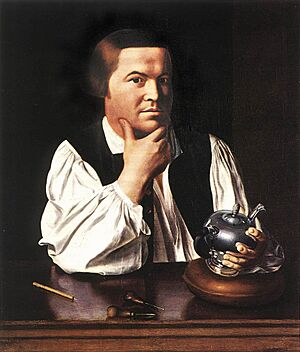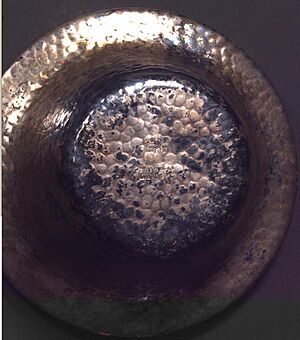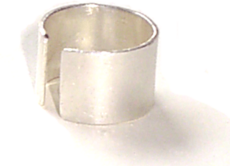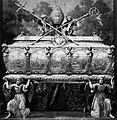Silversmith facts for kids
A silversmith is a skilled artist who creates beautiful objects from silver. Think of them as metal artists! While they are similar to goldsmiths, who work with gold, silversmiths often make larger items. They craft everything from fancy dishes and cups to jewelry and decorations.
Contents
History of Silversmiths

Long ago, in places like the ancient Near East, silver was not as expensive as gold. This meant silversmiths could make many items and keep them ready to sell. Around 300 A.D., there were rules about how much a silversmith could charge for their work.
In those times, groups called "guilds" were formed. These guilds helped silversmiths settle disagreements. They also protected their members and taught people about the craft.
During the Middle Ages in Europe and England, silversmiths also had guilds. They passed down their tools and skills to new students, called apprentices. These guilds helped keep the quality of silverwork very high. However, they sometimes made it harder for new ideas to appear.
In the 1600s, some silversmiths moved to America. There, they had more freedom to try new things. This helped silverworking become an important part of America's growth in technology and industry.
Tools, Materials, and Techniques
Silversmiths use many special tools to shape silver. They cut shapes from flat sheets of silver using saws or snips. Then, they use different kinds of hammers to shape the metal. They often work the silver over anvils and special metal forms called stakes.
Here are some tools and materials they use:
- saws (like a jeweler's saw)
- snips (for cutting metal)
- Files (to smooth edges)
- Many types of hammers (planishing, raising, cross-pein, ball-pein)
- anvils and stakes (for shaping)
- swage blocks (for bending metal)
- solder (a special metal that melts easily to join pieces)
- flux (a chemical that helps solder flow)
- torches or blow-pipes (for heating)
- pickle (a liquid to clean the silver)
- buffing wheels and polishing compounds (to make silver shiny)
Silver is usually hammered when it is cold, at room temperature. When silver is hammered or bent, it gets harder. This is called 'work-hardening'. To make the metal soft again, silversmiths use a process called annealing. This involves heating the silver. If the metal gets too hard and is not annealed, it can crack and break.
Silversmiths can also use a method called casting. This is like pouring melted silver into a mold. They use casting to make small parts like knobs, handles, or feet for their silver pieces.
After all the parts are shaped, they are put together. Silversmiths join pieces by soldering them or by using small metal pins called rivets.
In the past, silversmiths used charcoal or coke fires and blow-pipes for heating. Today, most silversmiths use gas torches. Some even use laser beam welding!
Silversmiths often practice their skills using copper and brass. These metals work similarly to silver but are much cheaper.
Famous Silversmiths
Many talented people have been silversmiths throughout history. Here are a few well-known ones:
- Hester Bateman: A very famous English silversmith.
- Peter Bentzon: One of the first American silversmiths of African background whose work has been found.
- Benvenuto Cellini: A famous Italian artist who worked with many metals.
- Georg Jensen: A Danish designer known for his beautiful silver pieces.
- Paul Revere: A famous American silversmith, manufacturer, and patriot. He is well-known for his ride during the American Revolution.
- Atsidi Sani: The first known Navajo silversmith, also called "Old Smith."
- Sequoyah: A Cherokee silversmith who also invented the Cherokee writing system.
- Zahroun Amara: A very famous Mandaean silversmith known for his special "niello" silverwork.
Images for kids
-
Embossed silver sarcophagus of Saint Stanislaus in the Wawel Cathedral, created in the main centers of 17th-century European silversmithery – Augsburg and Gdańsk
See also
 In Spanish: Platero para niños
In Spanish: Platero para niños
- Yemenite silversmithing
- Goldsmith




